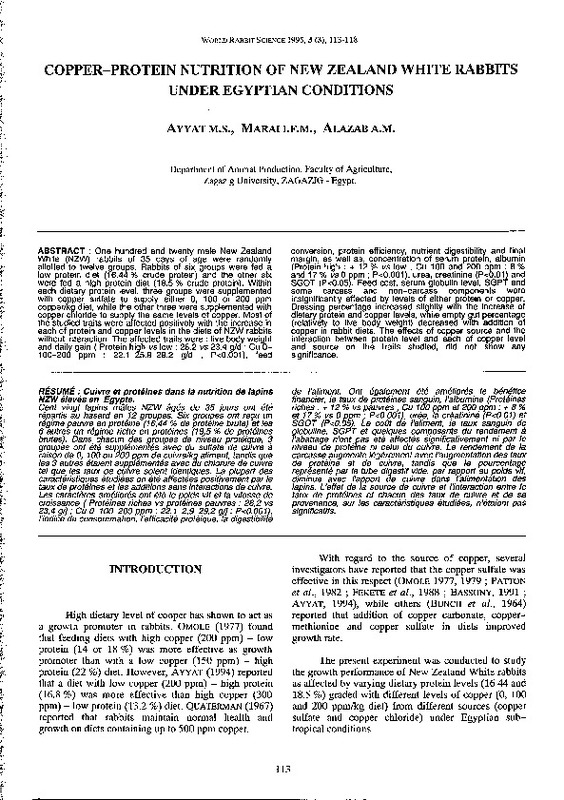JavaScript is disabled for your browser. Some features of this site may not work without it.
Buscar en RiuNet
Listar
Mi cuenta
Estadísticas
Ayuda RiuNet
Admin. UPV
COPPER-PROTEIN NUTRITION OF NEW ZEALAND WHITE RABBITS UNDER EGYPTIAN CONDITIONS
Mostrar el registro sencillo del ítem
Ficheros en el ítem
| dc.contributor.author | AYYAT, M.S.
|
|
| dc.contributor.author | MARAI, I.F.M.
|
|
| dc.contributor.author | ALAZAB, A.M.
|
|
| dc.date.accessioned | 2011-03-21T14:07:39Z | |
| dc.date.available | 2011-03-21T14:07:39Z | |
| dc.date.issued | 1995 | |
| dc.identifier.issn | 1257-5011 | |
| dc.identifier.uri | http://hdl.handle.net/10251/10503 | |
| dc.description.abstract | [EN] One hundred and twenty male New Zealand White (NZW) rabbits of 35 days of age were randomly allotted to twelve groups. Rabbits of six groups were fed a low protein diet (f6.44 % crude protein) and the other six were fed a high protein diet (18.5 % crude protein). Within each dietary protein level, three groups were supplemented with copper sulfate to supply e1ther O, 100 or 200 ppm copper/kg diet, while the other three were supplemented with copper cflloride to supply the same levels of copper. Most of the studied traits were affected positively with the increase in each of protein and copper levels in the diets of NZW rabbits without interaction. The affected traits were : live body weight and daily gain ( Protein high vs low : 28.2 vs 23.4 g/d ; Cu 0- 100-200 ppm : 22.1-25.9-29.2 g/d ; P<0.001), feed conversion, protein efficiency, nutrient digestibility and final margin, as well as, concentration of serum protem, albumin (Protein high : + 12 % vs low ; Cu 100 and 200 ppm : 8 % and 17 % vs O ppm ; P<0.001), urea, creatinine (P<0.01) and SGOT (P<0.05). Feed cost, serum globulin level, SGPi and sorne carcass and non-carcass components were insignificantly affected by levels of either protein or copper. Dressing percentage increased slightly with the increase of dietary protein and copper levels, while empty gut percentage (relatively to live body weight) decreased w1th addition of copper in rabbit diets. The effects of copper source and the interaction between protein level and each of copper level and source on the traits studied, did not show any significance. | es_ES |
| dc.description.abstract | [FR] Cent vingt lapins males NZW agés de 35 jours ont été répartis au hasard en 12 groupes. Six groupes ont re<;u un regime pauvre en protéine (16,44 % de proteine brute) et les 6 autres un régime riche en protéines (18,5 % de protéines brutes). Dans chacun des groupes de niveau protéique, 3 groupes ont été supplémentés avec du sulfate de cuivre a raison de O, 100 ou 200 ppm de cuivre/kg aliment, tandis que les 3 autres étaient supplémentés avec du chlorure de cwvre te/ que les taux de cwvre soient identiques. La plupart des caractéristiques étudiées on été affectées positivement par le taux de protéines et les additions sans interactions de cuivre. Les caracteres améliorés ont été le poids vif et la vitesse de croissance ( Protéines riches vs protéines pauvres : 28,2 vs 23,4 g/j; Cu 0-100-200 ppm: 22, 1-2,9-29,2 g/j; P<0.001), /'indice de consommation, l'efficacité protéique, la digestibilité de l'alirnent. Ont également été améliorés le bénéfice financier, le taux de protéines sanguin, /'albumine (Protéines riches : + 12 % vs pauvres ; Cu 100 ppm et 200 ppm : + 8 % et 17 % vs O ppm; P<0.001), urée, la créatinine (P<0.01) et SGOT (P<0.05). Le cout de l'aliment, le taux sanguin de globuline, SGPT et quelques composants du rendement a l'abattage n'ont pas été affectés significativement ni par le niveau de protéme ni celui du cuivre. Le rendement de la carcasse augmente légerement avec l'augmentation des taux de protéine et de cuivre, tandis que le pourcentage représenté par le tube digestif vide, par rapport au poids vif, diminue avec l'apport de cuivre dans l'alimentation des lapins. L 'effet de la source de cuivre et l'interaction entre le taux de protéines et chacun des taux de cuivre et de sa provenance, sur les caractéristiques étudiées, n'étaient pas significatifs. | |
| dc.language | Inglés | es_ES |
| dc.publisher | World Rabbit Science. ICTA. UPV | es_ES |
| dc.relation.ispartof | World Rabbit Science | |
| dc.rights | Reserva de todos los derechos | es_ES |
| dc.title | COPPER-PROTEIN NUTRITION OF NEW ZEALAND WHITE RABBITS UNDER EGYPTIAN CONDITIONS | es_ES |
| dc.type | Artículo | es_ES |
| dc.date.updated | 2011-03-21T14:00:14Z | |
| dc.identifier.doi | 10.4995/wrs.1995.249 | |
| dc.rights.accessRights | Abierto | es_ES |
| dc.description.bibliographicCitation | Ayyat, M.; Marai, I.; Alazab, A. (1995). COPPER-PROTEIN NUTRITION OF NEW ZEALAND WHITE RABBITS UNDER EGYPTIAN CONDITIONS. World Rabbit Science. 3(3). https://doi.org/10.4995/wrs.1995.249 | es_ES |
| dc.description.accrualMethod | SWORD | es_ES |
| dc.relation.publisherversion | https://doi.org/10.4995/wrs.1995.249 | |
| dc.description.volume | 3 | |
| dc.description.issue | 3 | |
| dc.identifier.eissn | 1989-8886 | es_ES |








